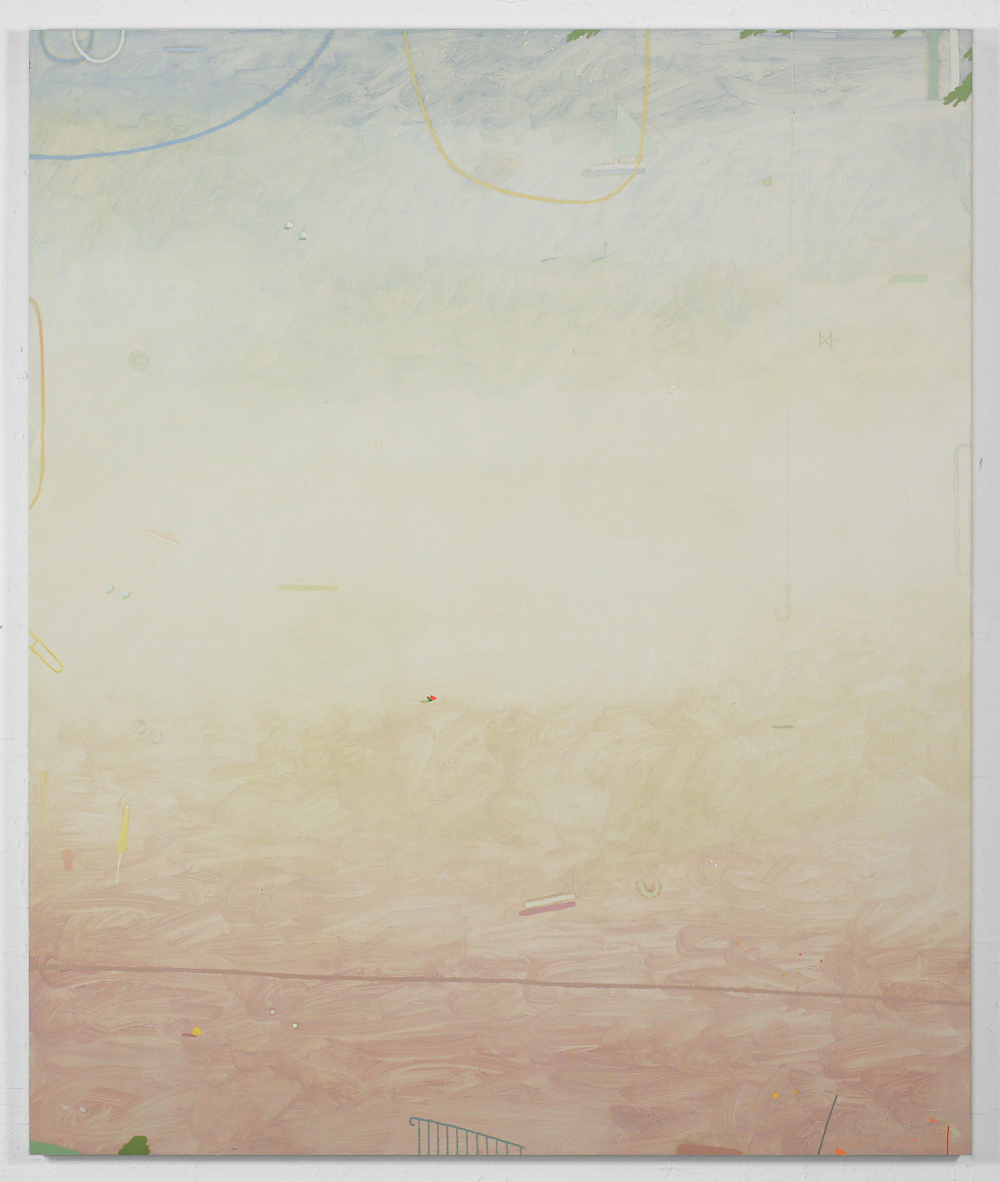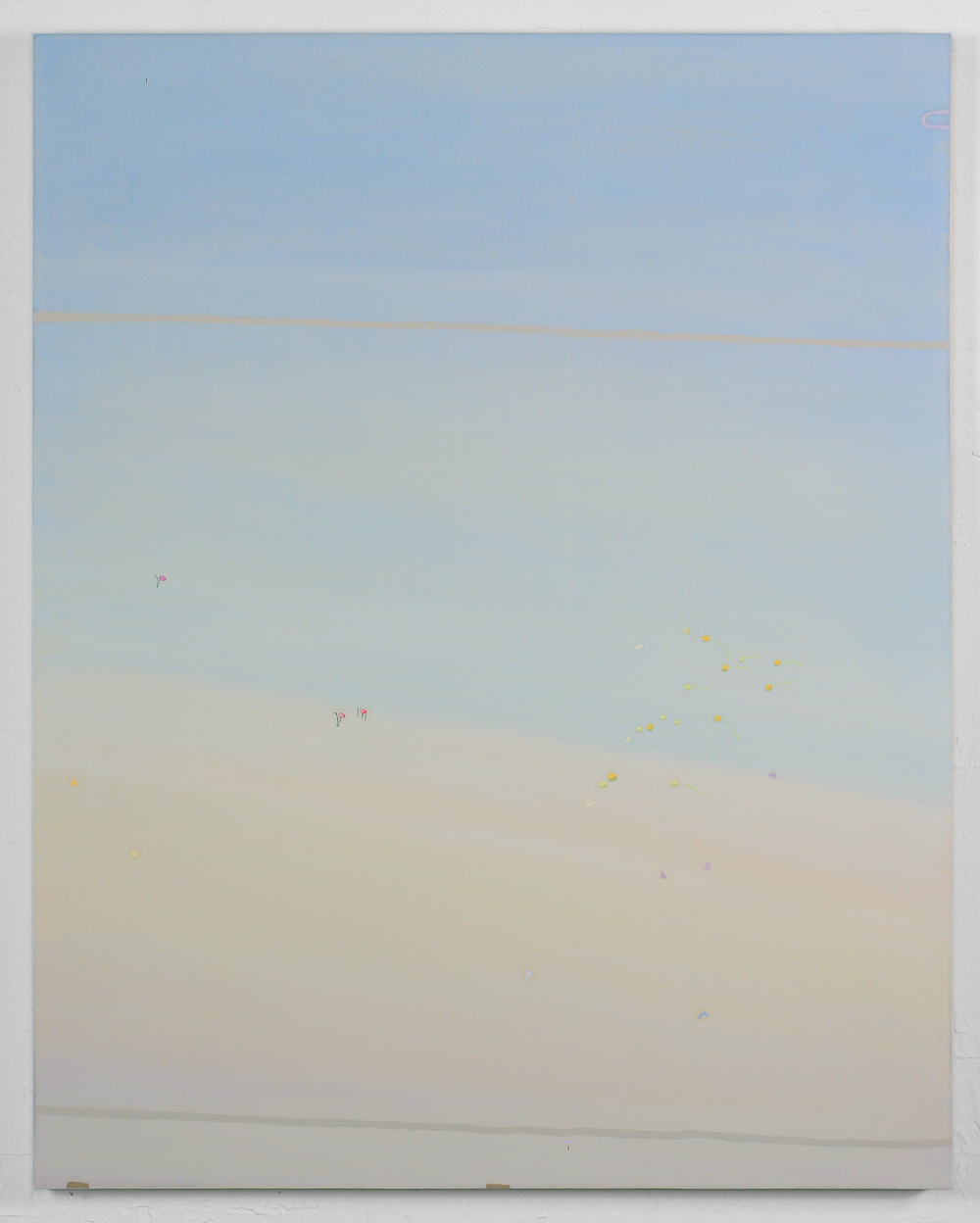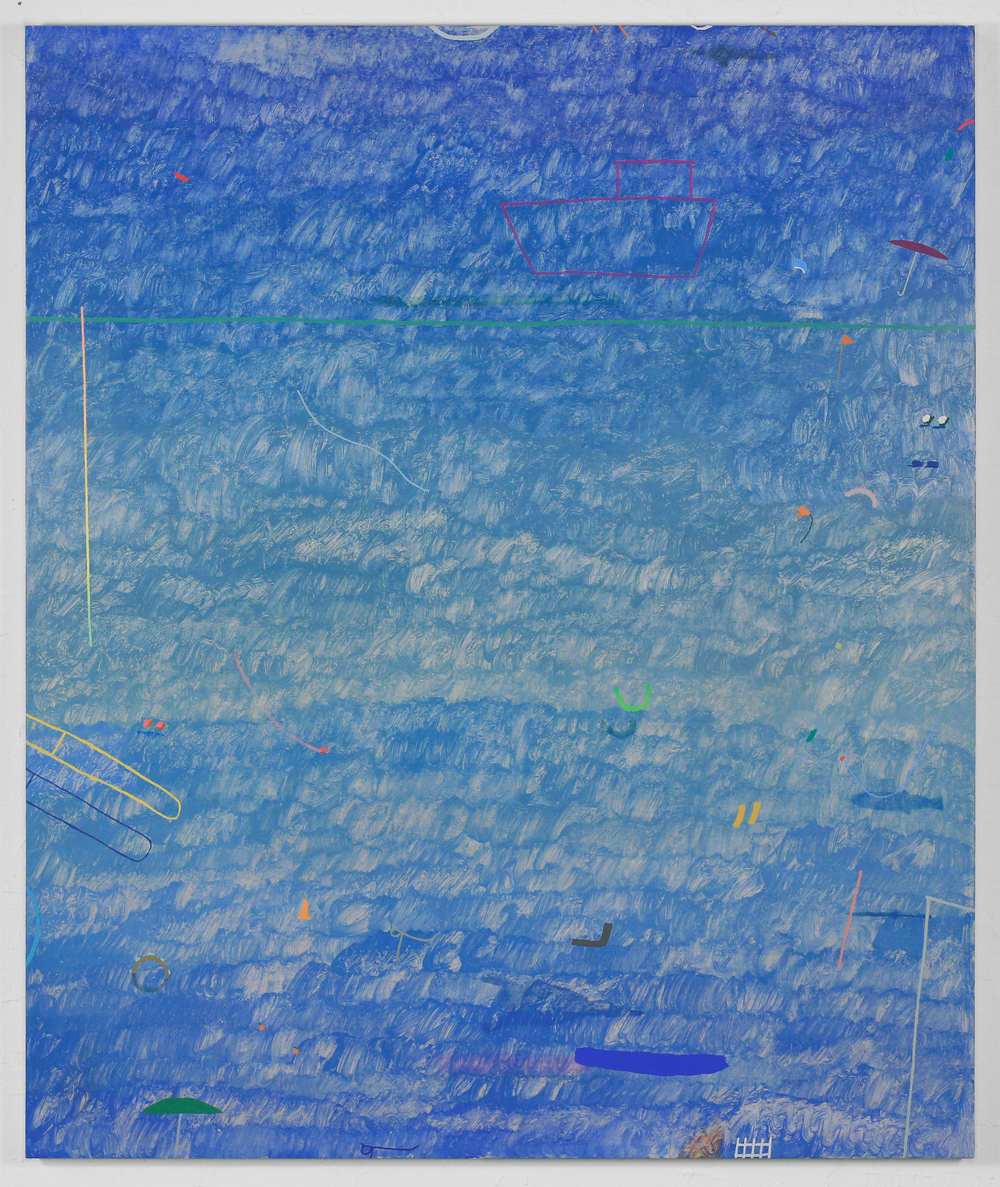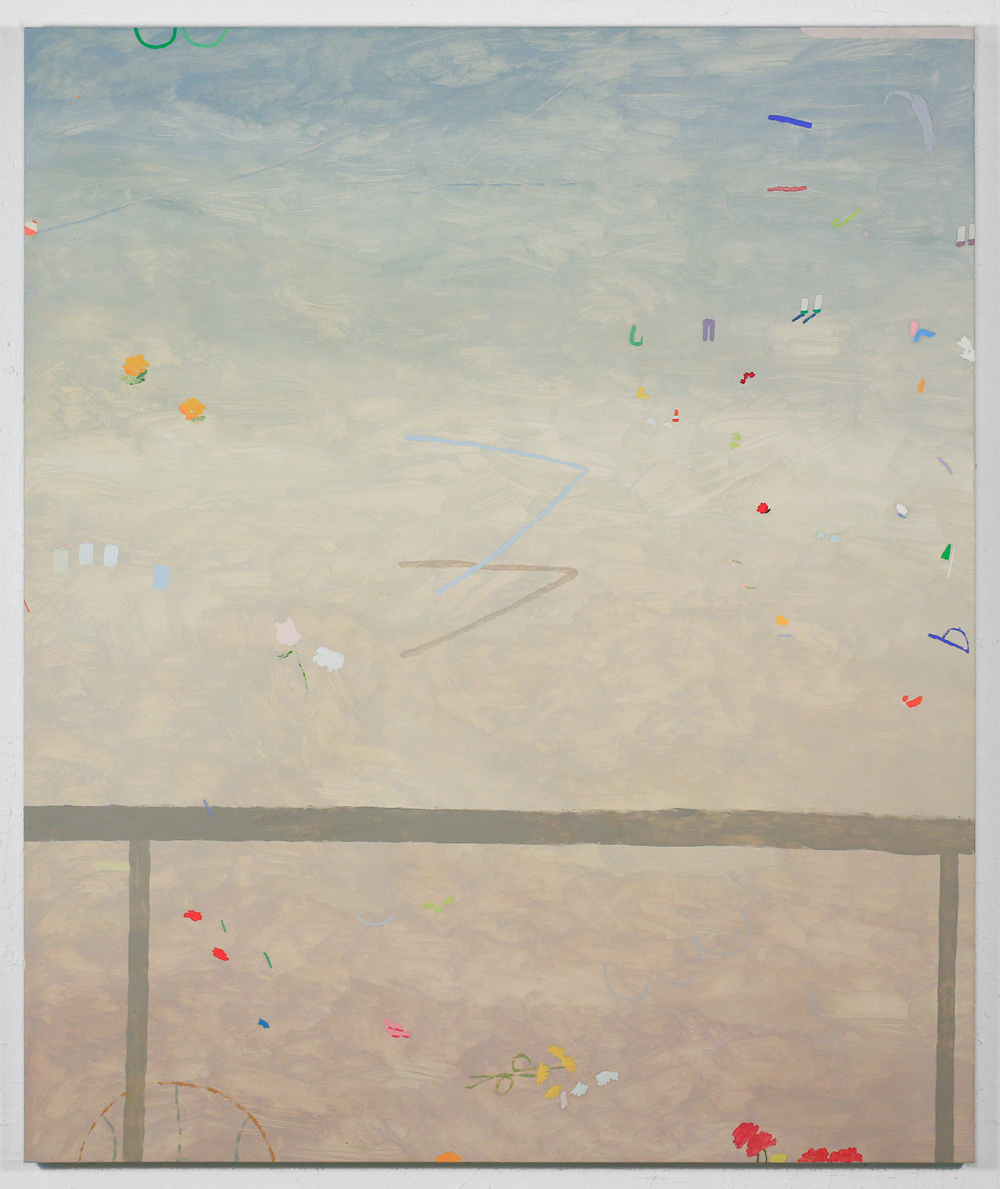“The sea was indistinguishable from the sky”: Observational Paintings by Mariel Capanna
by Laurel V. McLaughlin
I looked into his eyes
which were far larger than mine
but shallower, and yellowed,
the irises backed and packed
with tarnished tinfoil
seen through the lenses
of old scratched isinglass.
They shifted a little, but not
to return my stare.
—It was more like the tipping
of an object toward the light.
–Elizabeth Bishop (1911–1979), “The Fish,” 19461
The sun had not yet risen. The sea was indistinguishable from the sky […].
–Virginia Woolf, The Waves, 19312
Poet Elizabeth Bishop describes the intimate and strange act of looking into the eyes of a fish, observing the size, color, and texture. They are far from glowing and orb-like; but nevertheless, they dimly glimmer in their puckers and divots. They do not return her stare; and in them, she does not see her own reflection. Instead, they move, catching the spontaneity of light through perspectival shift. Bishop’s observations, rendered without flash or flourish, disclose the apparent distinction between subjectivity and objectivity, while simultaneously evading the primacy of the binary. Much like Bishop’s quiet interactions with a fish and probing speculations concerning the depth of perception, artist Mariel Capanna’s recent paintings configure basal shifts, both painted and interior. By forgoing a reliance on individual perception for multidimensional experience, pivoting painting towards temporality, and inverting composition, Capanna offers mesmeric viewing experiences.

Mariel Capanna, Sailboat, Parasol, Fishing Line, Swan, 2021

Mariel Capanna, Wildflowers, Chair, 2021
Sailboat, Parasol, Fishing Line, Swan and Wildflowers, Chair both exude an eerie Turner-esque mist, a sight that Capanna witnesses daily in the course of painting while living in a cabin on Wesserunsett Lake at Skowhegan School of Painting and Sculpture in Madison, ME, during her 2021 summer teaching fresco painting. Despite the thick totality of the haze, with time Capanna makes out multiple distinct elements. In the works, creatures in carefully applied oil mixed with marble dust and wax creep out from seemingly nowhere across thin layers of oil paint. Colors float atop swaths of moving sky and reflections of the water composed from the chalky rabbit skin glue of the gesso ground—an undulating feature in this current body of work and those in Capanna’s 2021 solo exhibition Overlook3. A boat and a guardrail in Sailboat, Parasol, Fishing Line, Swan, and flowers and critters in Wildflowers, Chair materialize gradually throughout the waves and flecks of sunlight. The experience of looking through the veil of mist challenges not only how Capanna perceives but what and how much.4 While her eyes absorb various aspects of the natural surroundings—perhaps more than she thought possible at first—she is also perceived by others, small creatures both sentient and non-sentient. It is as if perception itself is diverted from presumed singularity and refracted through multidimensional eyes. The experience mirrors the multitemporal soliloquies of Virginia Woolf’s six characters in her experimental novel The Waves, that describe the distinct perspectives of six characters over a lifetime of shared experiences interspersed with third-person visions of the rising and setting sun over the course of a single day. Capanna too experiences manifold walks of life at Skowhegan, as national and international artists and thinkers co-mingle in the communal experience of learning. This perceptual differentiation and diffusion infuses these works in both their making and atmospheric rhythms.

Mariel Capanna, Trombone, Pontoon, Loon Shadow, Hook, 2021

Mariel Capanna, Greater Than, Fishing Bobber, Scattered Flowers, Cap, 2021
Such perception expands in the blue energetic brushstrokes of Trombone, Pontoon, Loon Shadow, Hook, bestowing temporal agency upon the waves. Indeed, the condition of time deeply influences Capanna’s sense of perception. Time-based techniques from her work in fresco painting carry over into her oil painting as evinced in works such as Trombone, Pontoon, Loon Shadow, Hook and Greater Than, Fishing Bobber, Scattered Flowers, Cap. Capanna builds up gesso on the panel, accumulating stratigraphic layers over the course of multiple days as she takes in her surroundings—the lake water, striated sky, or the interior wall of her cabin. Afterwards, Capanna paints the surface quickly, attempting to gather the day in Woolfian fashion. Before a TV monitor she races against an allotted time—the fresco “giornata”—or the moment at the end of fresco painting when, as she recalls, “the wall no longer accepts the mark.”5 The TV media too lends another temporal overlay. As she describes in an interview with collaborator and interdisciplinary artist Africanus Okokon, Capanna watches documentaries, slideshows of found family photographs, and found analog film footage of parades, parties, protests, sporting events, and family gatherings from various decades and in differing speeds. At times she quickly works when apprehending a salient image; and at others, she slowly loses course amidst her watching, as she says:
The disorientation, the forgetting, the losing-track-of-things involved in your process of hand-animating film cells resonate with me […]. When I paint from movies, I watch the screen until some color or shape in-frame catches my eye, then I turn toward my palette to find or mix that color, then I turn toward my painting to jot down that shape. In all the time that I’m paint-mixing and brush-wielding, I’m necessarily missing many minutes of footage, which means that, inevitably, I’m also missing dozens of visual treasures that I could have otherwise caught and collected.6
Capanna’s visual tracking of fleeting televisual images, alongside the recollection of the remembered outdoor scenes from days prior and her temporal constraints, amalgamates disparate times. The frenetic coterminous brushstrokes register this multi temporality in Trombone, Pontoon, Loon Shadow, Hook, animating the blue water and the multiplicity of elements, such as a bird swimming underwater, a floating umbrella, and a white picket fence, all seemingly from other spatio-temporal realms that nonetheless find themselves bobbing in waves of paint. This same temporal density pervades Greater Than, Fishing Bobber, Scattered Flowers, Cap, as the mark-making activates the very atoms in the sky, or the lake, or both, causing space-time itself to buzz. Tiny impasto marks of flat color in pale lavender, umber, lime green, and muted yellow drift through this energetic, shape-shifting field much like streamers in a parade wind—a reference upon which Capanna draws deeply having witnessed countless victory parades, New Year parades, and funeral parades.7 The concatenation of lived (and deceased) experiences, processional movement through urban space, and communal orientations to music creates a temporal assembly that Capanna replicates upon the painted surface, enveloping viewers as the water-sky itself seems to tilt towards us.
![]()
Mariel Capanna, Lightbulb, Apple, Ladder, Chair, 2021
![]()
Mariel Capanna, Ping-Pong Paddle, Bear's Ears, Net, 2021
The multi-perspectival and -temporal processes involved in the creation of these paintings necessarily transforms viewers’ relationships to perspective and time, but also space. The boldly graphic horizontals, albeit softened by their tempered hues, emphatically buttress this shift. In Lightbulb, Apple, Ladder, Chair, a line serves to bisect the space of the sky, transposing an expected horizon line into the vintage mauve-colored interior of Capanna’s cabin. Likewise in Ping-pong Paddle, Bear’s Ears, Net the missing horizon line emerges in vertical form as the siding along a window pane, rendering the perspective from the inside looking out. Instead of a supposedly available and organized vista, Capanna’s paintings provide viewers with slices of domestic space in close and level proximity to the outside world. Only a thin wall (of color) divides them. In earlier work, inspired by a 30,000-mile road trip in 2014 around the United States, Capanna examined the historical painted picturing of the “American West,” a mythology that “hinge[s] upon the horizon line as a series of vanishing points and as the great frontier.”8 Divesting the horizon line of its central supremacy discloses the opportunity for expanse to meet the foreground of interiority, both human and non-human. In Sailboat, Seagull, Fireworks, Fence, the lack of a horizon line and its neat bifurcation of celestial and terrestrial space erases the distinction between sky and sea, much like Bishop’s envisioning of tipping an object into the light that simultaneously differentiates and conjoins its features, and Woolf’s oneiric view of a melding sea and sky. For viewers, the immersive seeing of both and one, rather than a transitional “frontier,” opens an expanse of possibilities for the unbound sailboats, seagulls, fireworks, and fences that parade through Capanna’s paintings.
![]()
Mariel Capanna, Sailboat, Seagull, Fireworks, Fence, 2021
Laurel V. McLaughlin is a writer, curator, and art historian from Philadelphia based in Portland, OR (on the unceded lands of the Bands of Chinook, Clackamas, Cowlitz, Kathlamet, Molalla, Multnomah, Tualatin Kalapuya, and Wasco peoples). McLaughlin holds MAs from The Courtauld Institute of Art and Bryn Mawr College, and is currently a 2020–2021 Luce/ACLS Dissertation Fellow in American Art and History of Art Ph.D. Candidate at Bryn Mawr, writing a dissertation concerning performative migratory aesthetics. She has presented her research at conferences such as the Association for the Study of the Arts of the Present, Hong Kong; the College Art Association, New York; and Performance Studies International, Calgary. Her criticism and essays have been published in Art Papers, Art Practical, Performa Magazine, Contact Quarterly, Performance Research, PARtake: The Journal of Performance as Research, and Antennae: The Journal of Nature in Visual Culture, among others. She has organized exhibitions at the Pennsylvania Academy of the Fine Arts, FJORD Gallery, the University of Pennsylvania in collaboration with the Arthur Ross Gallery and the ICA Philadelphia, AUTOMAT Gallery, Vox Populi, the Center for Contemporary Art & Culture, and Paragon Arts Gallery. She is currently organizing the traveling survey, Emilio Rojas: tracing a wound through my body, September 2–November 13, 2021 at Lafayette College and co-edited a volume on the work of Tania El Khoury to be published by Amherst College Press in 2022.
1 Elizabeth Bishop, “The Fish,” Poets.org, Accessed 5 August 2021, https://poets.org/poem/fish-2.
2 Virginia Woolf, The Waves, ed. Mark Hussey (San Diego: Harvest Books of Harcourt, Inc., 1978), 3.
3 Overlook, Adams and Ollman, 6 Accessed 2021, https://adamsandollman.com/Past-Exhibitions.
4 Mariel Capanna in a conversation with the author over Zoom, 5 August 2021. I am grateful to Mariel Capanna for her generous exchange in this conversation and for sharing her current reading of Bishop and Woolf with me.
5 Mariel Capanna in an email with the author, 8 August 2021.
6 Mariel Capanna and Africanus Okokon, “Mariel Capanna and Africanus Okokon in conversation upon the occasion of Overlook, Capanna’s solo exhibition at Adams and Ollman,” Exchange, Adams and Ollman, Accessed 1 August 2021, https://adamsandollman.com/Overlook-Mariel-Capanna-and-Africanus-Okokon-in-conversation.
7 Mariel Capanna in a conversation with the author over Zoom, 5 August 2021. See also Capanna and Okokon,
“Mariel Capanna and Africanus Okokon in conversation upon the occasion of Overlook, Capanna’s solo exhibition at Adams and Ollman.”
8 Mariel Capanna, “A Single Painted Knot,” Offline Magazine, 8 August, 2014. Capanna describes this road trip at length in depth in Carly Rapaport-Stein, “I bumped into this thing that was painting: How Mariel Capanna uncovered her artistic self,” Mural Arts Philadelphia Website, June 28, 2016, https://www.muralarts.org/blog/bumped-thing-painting-mariel-capanna-uncovered-artistic-self/.

Mariel Capanna, Lightbulb, Apple, Ladder, Chair, 2021

Mariel Capanna, Ping-Pong Paddle, Bear's Ears, Net, 2021
The multi-perspectival and -temporal processes involved in the creation of these paintings necessarily transforms viewers’ relationships to perspective and time, but also space. The boldly graphic horizontals, albeit softened by their tempered hues, emphatically buttress this shift. In Lightbulb, Apple, Ladder, Chair, a line serves to bisect the space of the sky, transposing an expected horizon line into the vintage mauve-colored interior of Capanna’s cabin. Likewise in Ping-pong Paddle, Bear’s Ears, Net the missing horizon line emerges in vertical form as the siding along a window pane, rendering the perspective from the inside looking out. Instead of a supposedly available and organized vista, Capanna’s paintings provide viewers with slices of domestic space in close and level proximity to the outside world. Only a thin wall (of color) divides them. In earlier work, inspired by a 30,000-mile road trip in 2014 around the United States, Capanna examined the historical painted picturing of the “American West,” a mythology that “hinge[s] upon the horizon line as a series of vanishing points and as the great frontier.”8 Divesting the horizon line of its central supremacy discloses the opportunity for expanse to meet the foreground of interiority, both human and non-human. In Sailboat, Seagull, Fireworks, Fence, the lack of a horizon line and its neat bifurcation of celestial and terrestrial space erases the distinction between sky and sea, much like Bishop’s envisioning of tipping an object into the light that simultaneously differentiates and conjoins its features, and Woolf’s oneiric view of a melding sea and sky. For viewers, the immersive seeing of both and one, rather than a transitional “frontier,” opens an expanse of possibilities for the unbound sailboats, seagulls, fireworks, and fences that parade through Capanna’s paintings.

Mariel Capanna, Sailboat, Seagull, Fireworks, Fence, 2021
Laurel V. McLaughlin is a writer, curator, and art historian from Philadelphia based in Portland, OR (on the unceded lands of the Bands of Chinook, Clackamas, Cowlitz, Kathlamet, Molalla, Multnomah, Tualatin Kalapuya, and Wasco peoples). McLaughlin holds MAs from The Courtauld Institute of Art and Bryn Mawr College, and is currently a 2020–2021 Luce/ACLS Dissertation Fellow in American Art and History of Art Ph.D. Candidate at Bryn Mawr, writing a dissertation concerning performative migratory aesthetics. She has presented her research at conferences such as the Association for the Study of the Arts of the Present, Hong Kong; the College Art Association, New York; and Performance Studies International, Calgary. Her criticism and essays have been published in Art Papers, Art Practical, Performa Magazine, Contact Quarterly, Performance Research, PARtake: The Journal of Performance as Research, and Antennae: The Journal of Nature in Visual Culture, among others. She has organized exhibitions at the Pennsylvania Academy of the Fine Arts, FJORD Gallery, the University of Pennsylvania in collaboration with the Arthur Ross Gallery and the ICA Philadelphia, AUTOMAT Gallery, Vox Populi, the Center for Contemporary Art & Culture, and Paragon Arts Gallery. She is currently organizing the traveling survey, Emilio Rojas: tracing a wound through my body, September 2–November 13, 2021 at Lafayette College and co-edited a volume on the work of Tania El Khoury to be published by Amherst College Press in 2022.
1 Elizabeth Bishop, “The Fish,” Poets.org, Accessed 5 August 2021, https://poets.org/poem/fish-2.
2 Virginia Woolf, The Waves, ed. Mark Hussey (San Diego: Harvest Books of Harcourt, Inc., 1978), 3.
3 Overlook, Adams and Ollman, 6 Accessed 2021, https://adamsandollman.com/Past-Exhibitions.
4 Mariel Capanna in a conversation with the author over Zoom, 5 August 2021. I am grateful to Mariel Capanna for her generous exchange in this conversation and for sharing her current reading of Bishop and Woolf with me.
5 Mariel Capanna in an email with the author, 8 August 2021.
6 Mariel Capanna and Africanus Okokon, “Mariel Capanna and Africanus Okokon in conversation upon the occasion of Overlook, Capanna’s solo exhibition at Adams and Ollman,” Exchange, Adams and Ollman, Accessed 1 August 2021, https://adamsandollman.com/Overlook-Mariel-Capanna-and-Africanus-Okokon-in-conversation.
7 Mariel Capanna in a conversation with the author over Zoom, 5 August 2021. See also Capanna and Okokon,
“Mariel Capanna and Africanus Okokon in conversation upon the occasion of Overlook, Capanna’s solo exhibition at Adams and Ollman.”
8 Mariel Capanna, “A Single Painted Knot,” Offline Magazine, 8 August, 2014. Capanna describes this road trip at length in depth in Carly Rapaport-Stein, “I bumped into this thing that was painting: How Mariel Capanna uncovered her artistic self,” Mural Arts Philadelphia Website, June 28, 2016, https://www.muralarts.org/blog/bumped-thing-painting-mariel-capanna-uncovered-artistic-self/.